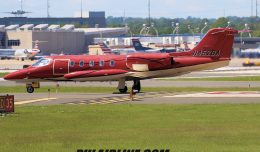Summary
Yesterday afternoon at 3:40pm ET, a McDonnell Douglas MD-83 operated by Ameristar Charters overran the runway on takeoff at Willow Run Airport in Detroit, Michigan. The aircraft was charted, carrying the University of Michigan men’s basketball team, all of whom evacuated safely with no major injuries, but some minor injuries have been reported.
There is no clear or known cause, or contributions to it, at this time.
Facts
Willow Run Airport (YIP) is categorized as a “reliever” airport for the nearby Detroit Metropolitan Wayne County Airport (DTW), but does not receive any scheduled airline service. They have multiple runways, two of which are parallel, ranging between about 6,000 and 7,500 in length, which is a respectable length for many aircraft types.
The McDonnell Douglas MD-83 is a rear, twin-engined aircraft, this one registered N786TW. It was first delivered via lease to Avianca in 1992, returned to its lessor and was then picked up by Ameristar and re-registered in 2011.
Ameristar Charters is a division of Ameristar Air Cargo Inc., formed in 2000 and is based in Dallas, Texas, that refers to Willow Run Airport as a hub. Their divisions offer passenger and cargo operations in a variety of aircraft types ranging from airliner type aircraft to that of corporate jets.
Accident
This aircraft’s crew aborted their takeoff for unknown reasons, and was unable to stop within the pavement of Runway 23L, which is 7,543ft long (for comparison, New York’s LaGuardia is 7,003ft long). It came to rest over 1,000ft beyond the end of the runway, slightly left of the centerline.
During flight planning and prior to departure, dispatchers and pilots are required to determine their ability to takeoff safely, and at which speed during the departure roll they would no longer be able to abort and stop within the provided runway length. Considered factors are the aircraft’s current overall weight, wind speed, wind direction, runway direction, barometric pressure, elevation, temperature, runway slope, obstacles beyond the runway and more. These calculations are even ensured to account for the loss of an engine at the most critical time of departure, to still allow for the aircraft to stop within remaining runway length, or continue the takeoff on one engine.
Hourly weather reports (known as a “METAR”) from the airport had not published wind information in almost 3 hours prior to the incident. The last reports that did include wind data, however, stated that the winds were offering a slightly off center headwind, at speeds of 33-35 knots sustained (40mph) with gusts up to 50 knots (58mph). Headwinds are beneficial to takeoff, as more air over the wing helps create more lift.
Though there was no METAR that indicated wind speed and direction in a few hours, air crews can and will receive current winds from the control tower. There is no word on what, if any, wind data the tower reported at that time.
This occurrence will likely be classified as an “accident” by Federal Aviation Administration definition, which defines an accident as requiring “death or serious injury, or in which the aircraft receives substantial damage,” during a flight operation. Though there were no fatalities or serious injuries, “substantial damage” looks to have taken place due to the aircraft having had is landing gear separated and striking objects while sliding.
Accident investigations by the NTSB can take up to and beyond a year. Firm, reliable information as to the cause of this accident may not be learned until that time.
Phil Derner founded NYCAviation in 2003. A lifetime aviation enthusiast that grew up across the water from La Guardia Airport, Phil has aviation experience as a Loadmaster, Operations Controller and Flight Dispatcher. He owns and operates NYCAviation and performs duties as an aviation expert through writing, consulting, public speaking and media appearances. You can reach him by email or follow him on Twitter.







